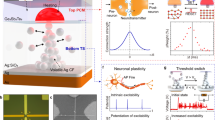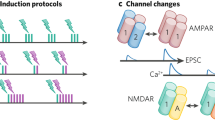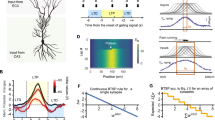Abstract
In the mammalian nervous system, various synaptic plasticity rules act, either individually or synergistically, over wide-ranging timescales to enable learning and memory formation. Hence, in neuromorphic computing platforms, there is a significant need for artificial synapses that can faithfully express such multi-timescale plasticity mechanisms. Although some plasticity rules have been emulated with elaborate complementary metal oxide semiconductor and memristive circuitry, device-level hardware realizations of long-term and short-term plasticity with tunable dynamics are lacking. Here we introduce a phase-change memtransistive synapse that leverages both the non-volatility of the phase configurations and the volatility of field-effect modulation for implementing tunable plasticities. We show that these mixed-plasticity synapses can enable plasticity rules such as short-term spike-timing-dependent plasticity that helps with the modelling of dynamic environments. Further, we demonstrate the efficacy of the memtransistive synapses in realizing accelerators for Hopfield neural networks for solving combinatorial optimization problems.
This is a preview of subscription content, access via your institution
Access options
Access Nature and 54 other Nature Portfolio journals
Get Nature+, our best-value online-access subscription
$32.99 / 30 days
cancel any time
Subscribe to this journal
Receive 12 print issues and online access
$259.00 per year
only $21.58 per issue
Buy this article
- Purchase on SpringerLink
- Instant access to full article PDF
Prices may be subject to local taxes which are calculated during checkout





Similar content being viewed by others
Data availability
The data that support the findings of this study are available from the corresponding author upon reasonable request.
References
Prezioso, M. et al. Training and operation of an integrated neuromorphic network based on metal-oxide memristors. Nature 521, 61–64 (2015).
Bliss, T. V. P. & Collingridge, G. L. A synaptic model of memory: long-term potentiation in the hippocampus. Nature 361, 31–39 (1993).
Nessler, B., Pfeiffer, M., Buesing, L. & Maass, W. Bayesian computation emerges in generic cortical microcircuits through spike-timing-dependent plasticity. PLOS Comput. Biol. 9, e1003037 (2013).
Scellier, B. & Bengio, Y. Equilibrium propagation: bridging the gap between energy-based models and backpropagation. Front. Comput. Neurosci. 11, 24 (2017).
Citri, A. & Malenka, R. C. Synaptic plasticity: multiple forms, functions, and mechanisms. Neuropsychopharmacology 33, 18–41 (2008).
Grande, L. A. & Spain, W. J. Synaptic depression as a timing device. Physiology 20, 201–210 (2005).
Szatmáry, B. & Izhikevich, E. M. Spike-timing theory of working memory. PLoS Comput. Biol. 6, e1000879 (2010).
Fiebig, F. & Lansner, A. A spiking working memory model based on hebbian short-term potentiation. J. Neurosci. 37, 83–96 (2017).
Brenowitz, S. D. & Regehr, W. G. Associative short-term synaptic plasticity mediated by endocannabinoids. Neuron 45, 419–431 (2005).
Cassenaer, S. & Laurent, G. Hebbian stdp in mushroom bodies facilitates the synchronous flow of olfactory information in locusts. Nature 448, 709–713 (2007).
Erickson, M. A., Maramara, L. A. & Lisman, J. A single brief burst induces glur1-dependent associative short-term potentiation: a potential mechanism for short-term memory. J. Cogn. Neurosci. 22, 2530–2540 (2010).
Moraitis, T., Sebastian, A. & Eleftheriou, E. Short-term synaptic plasticity optimally models continuous environments. Preprint at https://arxiv.org/abs/2009.06808 (2020).
Buonomano, D. & Carvalho, T. A novel learning rule for long-term plasticity of short-term synaptic plasticity enhances temporal processing. Front. Integr. Neurosci. 5, 20 (2011).
Regehr, W. G. Short-term presynaptic plasticity. Cold Spring Harb. Perspect. Biol. 4, a005702 (2012).
Ohno, T. et al. Short-term plasticity and long-term potentiation mimicked in single inorganic synapses. Nat. Mater. 10, 591–595 (2011).
Moraitis, T., Sebastian, A. & Eleftheriou, E. The role of short-term plasticity in neuromorphic learning: Learning from the timing of rate-varying events with fatiguing spike-timing-dependent plasticity. IEEE Nanotechnol. Mag. 12, 45–53 (2018).
Royer, S. & Paré, D. Conservation of total synaptic weight through balanced synaptic depression and potentiation. Nature 422, 518–522 (2003).
Gkoupidenis, P., Koutsouras, D. A. & Malliaras, G. G. Neuromorphic device architectures with global connectivity through electrolyte gating. Nat. Commun. 8, 15448 (2017).
Wang, Z., Joshi, S. & Savel, ea Memristors with diffusive dynamics as synaptic emulators for neuromorphic computing. Nat. Mater. 16, 101–108 (2016).
Xia, Q. & Yang, J. J. Memristive crossbar arrays for brain-inspired computing. Nat. Mater. 18, 309–323 (2019).
Sangwan, V. K. et al. Multi-terminal memtransistors from polycrystalline monolayer molybdenum disulfide. Nature 554, 500–504 (2018).
Lee, H.-S. et al. Dual-gated MoS2 memtransistor crossbar array. Adv. Funct. Mater. 30, 2003683 (2020).
Sarwat, S. G. Materials science and engineering of phase change random access memory. Mater. Sci. Technol. 33, 16 (2017).
Sebastian, A. et al. Tutorial: brain-inspired computing using phase-change memory devices. J. Appl. Phys. 124, 111101 (2018).
Liao, F. et al. Characterization of Ge2Sb2Te5 thin film transistor and its application in non-volatile memory. Microelectron. J. 37, 841–844 (2006).
Daus, A., Han, S., Knobelspies, S., Cantarella, G. & Tröster, G. Ge2Sb2Te5 p-type thin-film transistors on flexible plastic foil. Materials 11, 1672 (2018).
Wahid, S. et al. Lateral transport and field-effect characteristics of sputtered p-type chalcogenide thin films. Preprint at https://arxiv.org/abs/2107.08301 (2021).
Gerstner, W., Lehmann, M., Liakoni, V., Corneil, D. & Brea, J. Eligibility traces and plasticity on behavioral time scales: experimental support of neohebbian three-factor learning rules. Front. Neural Circuits 12, 53 (2018).
Neftci, E. O., Pedroni, B. U., Joshi, S., Al-Shedivat, M. & Cauwenberghs, G. Stochastic synapses enable efficient brain-inspired learning machines. Front. Neurosci. 10, 241 (2016).
Tuma, T., Pantazi, A., Le Gallo, M., Sebastian, A. & Eleftheriou, E. Stochastic phase-change neurons. Nat. Nanotechnol. 11, 693–699 (2016).
Cook, D. L., Schwindt, P. C., Grande, L. A. & Spain, W. J. Synaptic depression in the localization of sound. Nature 421, 66–70 (2003).
Maass, W., Natschläger, T. & Markram, H. Real-time computing without stable states: a new framework for neural computation based on perturbations. Neural Comput. 14, 2531–2560 (2002).
Bi, G.-Q. & Poo, M.-M. Synaptic modifications in cultured hippocampal neurons: dependence on spike timing, synaptic strength, and postsynaptic cell type. J. Neurosci. 18, 10464–10472 (1998).
Van Rossum, M. C., Bi, G. Q. & Turrigiano, G. G. Stable hebbian learning from spike timing-dependent plasticity. J. Neurosci. 20, 8812–8821 (2000).
Bamford, S. A., Murray, A. F. & Willshaw, D. J. Spike-timing-dependent plasticity with weight dependence evoked from physical constraints. IEEE Trans. Biomed. Circuits Syst. 6, 385–398 (2012).
Bofill-i Petit, A. & Murray, A. F. Synchrony detection and amplification by silicon neurons with stdp synapses. IEEE Trans. Neural Netw. 15, 1296–1304 (2004).
Fernandes, D. & Carvalho, A. L. Mechanisms of homeostatic plasticity in the excitatory synapse. J. Neurochemistry 139, 973–996 (2016).
Watt, A. J. & Desai, S. N. Homeostatic plasticity and STDP: keeping a neuron’s cool in a fluctuating world. Front. Synaptic Neurosci. 2, 5 (2010).
Bains, A. S. & Schweighofer, N. Time-sensitive reorganization of the somatosensory cortex poststroke depends on interaction between Hebbian and homeoplasticity: a simulation study. J. Neurophysiol. 112, 3240–3250 (2014).
Ruiz-Vanoye, J. A. et al. in Computational Intelligence and Modern Heuristics (IntechOpen, 2010).
Korte, B. H., Vygen, J., Korte, B. & Vygen, J. Combinatorial Optimization Vol. 1 (Springer, 2011).
Potvin, J.-Y. & Smith, K. A. in Handbook of Metaheuristics (eds. Glover, F. & Kochenberger, G. A.) 429–455 (Kluwer Academic Publishers, 2003).
Wu, L.-Y., Zhang, X.-S. & Zhang, J.-L. Application of discrete hopfield-type neural network for max-cut problem. In Proceedings of ICONIP 1439–1444 (2001).
Park, K., Kim, J. & Lee, J. Visual field prediction using recurrent neural network. Sci. Rep. 9, 8385 (2019).
Dietterich, T. G. Machine learning for sequential data: a review. In Joint IAPR International Workshops on Statistical Techniques in Pattern Recognition (SPR) and Structural and Syntactic Pattern Recognition (SSPR), 15–30 (Springer, Berlin, Heidelberg, 2002).
Cai, F. et al. Power-efficient combinatorial optimization using intrinsic noise in memristor hopfield neural networks. Nat. Electron. 3, 409–418 (2020).
Yang, K. et al. Transiently chaotic simulated annealing based on intrinsic nonlinearity of memristors for efficient solution of optimization problems. Sci. Adv. 6, eaba9901 (2020).
Kumar, S., Strachan, J. P. & Williams, R. S. Chaotic dynamics in nanoscale NbO2 mott memristors for analogue computing. Nature 548, 318–321 (2017).
Zhang, Z. et al. Truly concomitant and independently expressed short-and long-term plasticity in a Bi2O2Se-based three-terminal memristor. Adv. Mater. 31, 1805769 (2019).
Acknowledgements
We acknowledge funding for this work from the European Union’s Horizon 2020 Research and Innovation Programme (Fun-COMP project no. 780848) and from the European Research Council through the European Union’s Horizon 2020 Research and Innovation Programme under grant no. 682675. We also acknowledge technical input from A. Rahimi (Research Scientist, IBM Research-Zurich). We thank the cleanroom operations team of the Binnig and Rohrer Nanotechnology Center for their support.
Author information
Authors and Affiliations
Contributions
S.G.S and A.S. conceptualized the idea. S.G.S designed algorithms, performed experiments and analysed data with assistance from B.K and T.M. V.P.J., S.G.S. and B.K. fabricated the devices. S.G.S wrote the manuscript with input from all the authors.
Corresponding authors
Ethics declarations
Competing interests
The authors declare no competing interests.
Peer review
Peer review information
Nature Nanotechnology thanks Paschalis Gkoupidenis, Xiangshui Miao and the other, anonymous, reviewer(s) for their contribution to the peer review of this work.
Additional information
Publisher’s note Springer Nature remains neutral with regard to jurisdictional claims in published maps and institutional affiliations.
Supplementary information
Supplementary Information
Supplementary discussion and Figs. 1–9.
Rights and permissions
About this article
Cite this article
Sarwat, S.G., Kersting, B., Moraitis, T. et al. Phase-change memtransistive synapses for mixed-plasticity neural computations. Nat. Nanotechnol. 17, 507–513 (2022). https://doi.org/10.1038/s41565-022-01095-3
Received:
Accepted:
Published:
Issue date:
DOI: https://doi.org/10.1038/s41565-022-01095-3
This article is cited by
-
Probabilistic photonic computing for AI
Nature Computational Science (2025)
-
Integrating molecular photoswitch memory with nanoscale optoelectronics for neuromorphic computing
Communications Materials (2025)
-
Memristor-based hardware accelerators for artificial intelligence
Nature Reviews Electrical Engineering (2024)
-
Single neuromorphic memristor closely emulates multiple synaptic mechanisms for energy efficient neural networks
Nature Communications (2024)
-
A carbon-nanotube-based tensor processing unit
Nature Electronics (2024)



